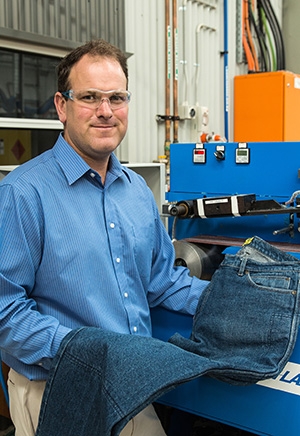A safer ride
Research news
They were already the safest jeans in the world, but a collaboration between Deakin and Australian jeans manufacturer Draggin’ Jeans means that Australia’s famous motorcycle denims are about to get a whole lot safer.
The CEO of Draggin’ Jeans showed just how safe his jeans were in the late nineties when he allowed himself to be dragged along the road in his jeans at over 100 kph. He got up and walked away without a scratch. Draggin’ Jeans has since become the world leader in denim / Kevlar motorcycle clothing.
Dr Chris Hurren, Textiles Research Fellow within Deakin’s Institute for Frontier Materials, has been working on further improving the abrasion resistance of Draggin’s denim jeans.
Through modifying the placement and types of fibres used in the protective layer, Dr Hurren has been able to almost double the abrasion resistance of the current fabric. Kevlar is well known for its outstanding strength, being used in bullet proof clothing, body armour, sports equipment, brakes and various other applications. Synthesised from polymers, it is lightweight, yet has five times the strength of steel on an equal-weight basis.
However, if the Kevlar is not used correctly it will provide little or no protection to the wearer. The structure of the protective layer is key to protecting the rider when they slide. Most other manufacturers neglect this factor, putting any fabric made from Kevlar into their product, often with disastrous implications for the rider. The key to developing the protective layer is rigorous testing with Deakin’s belt abrasion tester, the only one of its kind in Australia. This provides researchers with a good understanding of the way the product performs and has given Draggin’ the edge over its competitors.
“We have a saying, that the fabric is worn by motorcyclists, tortured by scientists,” Dr Hurren said. “But it can really mean the difference between life and death. Sooner or later, most motorcyclists will have an accident. Their bike could slip on a wet road, get bumped by other cars or undergo a myriad of other incidents that could bring them over.”
Dr Hurren said that seventy-five per cent of motorbike accidents occur at a speed below 50 kph, which gives riders a good chance of surviving. If they are wearing protective clothing, they will have 80 per cent less chance of sustaining injuries.
The problem is, however, that less than 45 per cent of motorcyclists wear protective clothing below their torso, despite the fact that 80 per cent of motorcycle injuries happen to this half of the body.
Based in Fisherman’s Bend, Draggin’ Jeans have developed the only denim jeans that meet European CE tests for abrasion, burst and tear resistance. The jeans are made with natural fibres and lined with soft, breathable Kevlar that has been knitted so that the loop of the weave faces the road, which acts to slow down the fallen cyclist, reduce friction and minimise injury.
Dr Hurren has been working in textiles at Deakin’s Waurn Ponds campus for 13 years, completing his PhD four years ago. He specialises in performance textiles and is also currently working on materials such as bullet proof vests, warmer clothes for high performance sports like sailing, and cut-proof clothing.
The Deakin upgrading job couldn’t have been given to a more enthusiastic researcher. Dr Hurren has a personal interest in motorbikes, with three BSA Bantams in his shed. These classics were used by posties in the 1950s and are Dr Hurren’s “pride and joy.” Becoming more acquainted with the accident statistics, however, has made him a more cautious rider. He always dons full protective gear before he goes out.
Draggin’ jeans that use the new material should be available in motorbike shops later this year.
Share this story
 Dr Chris Hurren
Dr Chris Hurren
